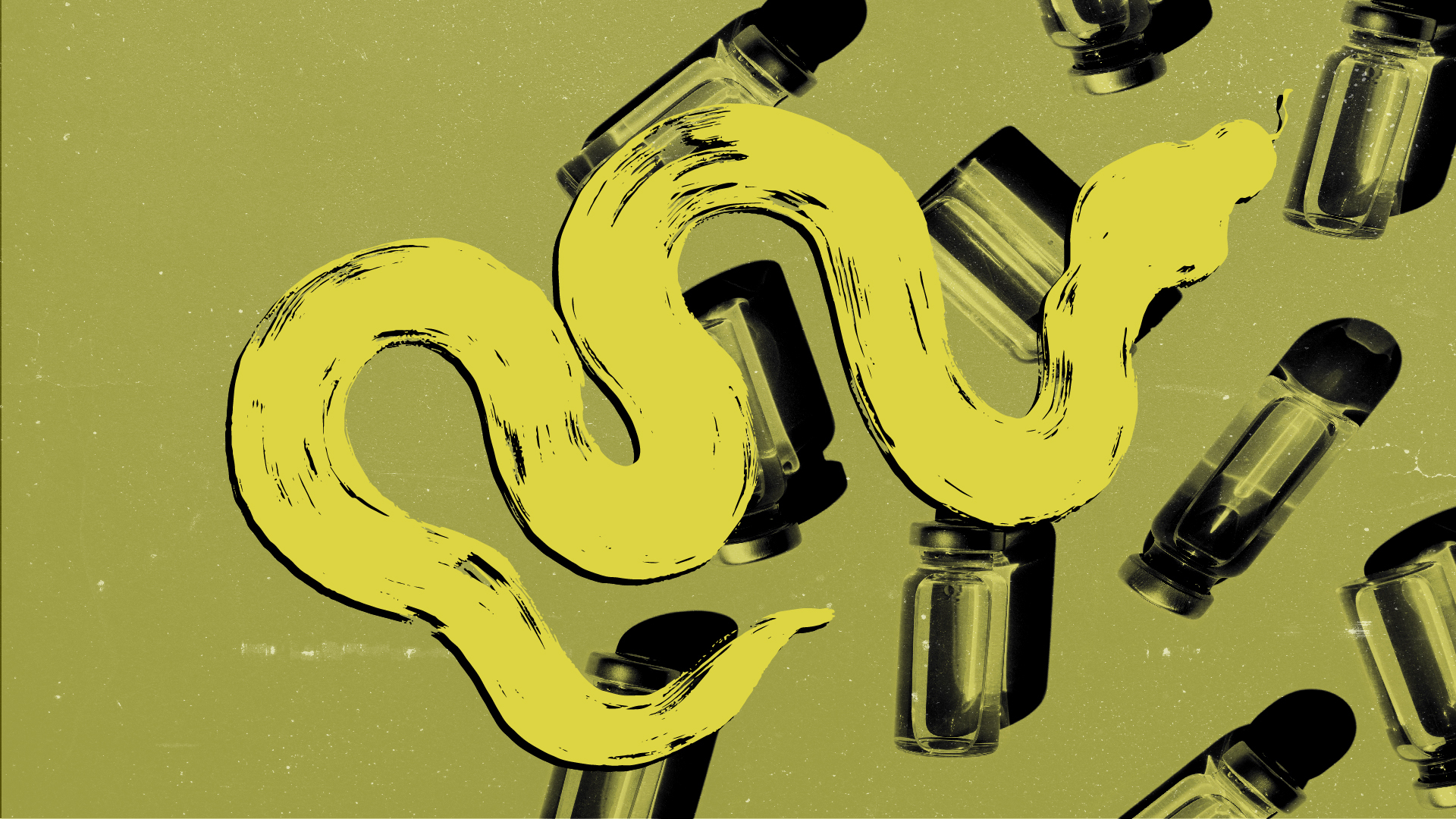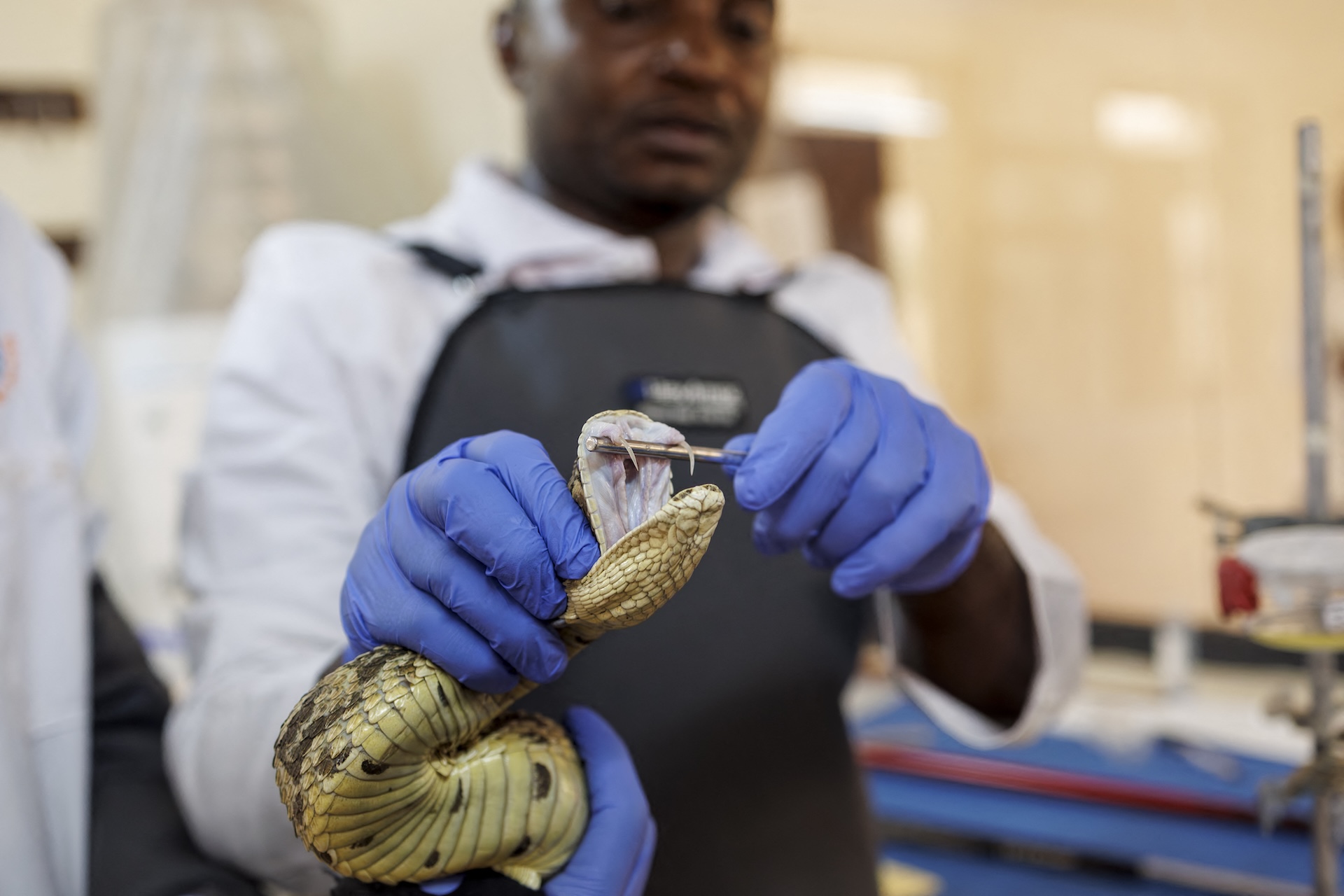Scientists could soon create a 'universal antivenom.' But would it save lives?
A recent study hints that we could make a universal antivenom for snakebites, but some scientists say we need something else instead.

When Jacob Glanville first spoke to Tim Friede, he said, "I'd love to get my hands on some of your blood."
As CEO of the biotech company Centivax, Glanville was developing a universal snakebite treatment. And Friede is a self-taught herpetologist with hyperimmunity to some of the world's deadliest snake toxins.
Over the past two decades, Friede has had over 800 snakebites and "self-immunizations" with the venom of cobras, taipans, black mambas, rattlers and more. By carefully increasing the doses of diluted venom, he "trained" his immune system to produce antibodies that worked against a broad variety of snake venom toxins.
What Glanville needed for his "universal" antivenom were several antibodies, each of which could neutralize many different versions of a toxin. That's no small task. A snake venom is a mixture of up to 70 toxins. And different snakes can produce different combinations, variants and amounts of these toxins, even in the same species across and within geographic regions. Even small chemical variations from one toxin to the next could result in a very different reaction to a bite, making an antivenom effective against one snakebite but ineffective against another.
But Glanville suspected it was still possible to achieve his goal, because structurally, all venom toxins are variations of around 10 protein classes. That suggests that the key sites where these proteins bind to human cells could be similar across many venoms.
If researchers could find antibodies that latch onto these common binding sites,"we could make a cocktail that could be a universal antivenom," Glanville said.
He was hoping that the antibodies in Friede's blood might work against some of those similar sites. With a 40-milliliter blood sample from Friede, Glanville worked with biochemist Peter Kwong and others from the National Institutes of Health and Columbia University to create a "broad-spectrum" antivenom. In 2025, Glanville, Kwong and colleagues reported that, in mice, a mix of three agents including some derived from antibodies in Friede's blood provided broad protection against the venom of 19 snakes of the elapid family, which has about 300 species, including various cobras, mambas, taipans and kraits.
Get the world’s most fascinating discoveries delivered straight to your inbox.
Glanville thinks his research shows that a universal antivenom is within reach. But other experts are skeptical of the need and practicality of this approach. What's needed, they say, is not a "universal antivenom." They'd rather see a suite of several antivenoms, with each one tailored to the snakes in a given geographic region and able to be made cheaply and quickly.
A photo posted by on
A toxic threat
Up to 138,000 people die of bites from venomous snakes every year, mostly in Africa, Asia and Latin America, according to the World Health Organization. These numbers may be an underestimate, however, because people who are bitten may not always seek medical treatment.
Plus, getting the right antivenom quickly is a challenge. People may not always know which snake has bitten them, as there are about 600 species of venomous snakes and often multiple venomous snake species in a given region..
Generally, the toxins in snake venom fall into three categories: neurotoxins, which damage the nervous system; hemotoxins, which disrupt blood flow and clotting; and cytotoxins, which damage cells and tissue.
Most elapids rely on neurotoxins. Among the deadliest types are three-finger toxins (3FTXs), so called because of the characteristic finger-like loops in these protein structures. The 3FTX family includes long- and short-chain neurotoxins (LNX and SNX), which are the most dangerous because they often bind swiftly and irreversibly to the receptors on muscle nerve cells, preventing them from firing.
If not counteracted, 3FTXs cause rapid muscle paralysis and death.
Developing a universal antivenom
To develop their new antivenom mixture, Glanville's team isolated DNA from Friede's blood and created a library of the antibodies in it that counteracted snake venom toxins. From these, they isolated those that neutralized many of the most dangerous ones.
You don't make a drug where you take insulin, Alzheimer medicine, cancer medicine, a medicine against bad breath, make it into one pill, and say, hey, [if you] suffer from one of these things, here, just take our multi-drug.
Andreas Hougaard Laustsen-Kiel, the Technical University of Denmark
"The way antivenoms work is, if you disable one [toxin], it neutralizes the whole thing," said Kartik Sunagar, an evolutionary geneticist who leads the Indian Institute of Science's Evolutionary Venomics Lab and is working to develop antivenoms for snakes found in specific regions in India. "This is how you can achieve broad neutralization, as many of these toxins are shared across species."
Glanville and colleagues found that an antibody called LNX-D09 was effective against LNXs, while another, SNX-B03, worked against SNXs. They combined these with a drug called varespladib, which was previously shown to neutralize another type of snake venom toxin, called phospholipase A2 (PLA2), which breaks down cell membranes, causing tissue death, inflammation, hemorrhage, or swelling . This cocktail protected mice from 19 venomous snake species — full protection against 13 species, and for the remaining six, it reduced the severity of symptoms. Their paper was published earlier this year in the journal Cell.
A daunting task
But the complexity of snake venoms makes developing a one-size-fits-all solution extremely daunting.
"A snakebite is not just one disease…[and] behind each snakebite is a different venom composition, The toxins important in African snakes may not even exist in any snake venom in the Americas," said Andreas Hougaard Laustsen-Kiel, a biotechnologist at the Technical University of Denmark who is working to develop broad-spectrum snakebite treatments. "The toxins important in African snakes may not even exist in any snake venom in the Americas."
Laustsen-Kiel doesn't think a universal antidote to snake venom is possible — or even necessary. "You don't make a drug where you take insulin, Alzheimer medicine, cancer medicine, a medicine against bad breath, make it into one pill, and say, hey, [if you] suffer from one of these things, here, just take our multi-drug," Laustsen-Kiel told Live Science.
He also cautioned against hyping the idea that a "universal" antivenom is near. Glanville's team's new antivenom cocktail is effective against snakes from many regions, but it works only for the venoms in the study.
"To a non-expert it might look like very broad neutralization, but all the species picked have venoms that are very similar," Laustsen-Kiel said. But the snakes highlighted in the study often have close cousins in the same regions that make venom that differs from those targeted in the new mixture, so it isn't likely to work on their venoms, he added.

Still, he said, Glanville and team's work is significant because it validates an approach that has been around for a decade. "If you go one by one, make good, broadly neutralizing antibodies, and make cocktails [of those], that is likely a good strategy for making better antivenoms."
Instead of trying to make a universal antivenom, a better approach would be to mix-and match a panel of broadly neutralizing antibodies specific to each geography, he said. This would mean targeting the venoms of snake species found in a given area, not the world over.
The century-old technology behind snake antivenom production
But there's another barrier to an ideal antivenom: Production still relies on the 125-year-old technology of injecting animals like horses or sheep with venom and using their antibodies to create antidotes for humans. There are many drawbacks to this approach. First, most snake species don't have specific antivenoms, and even if they do, their effectiveness can vary because of venom differences. Plus, nonhuman antibodies risk causing allergic reactions like anaphylaxis and serum sickness in some users.
What the field needs, Laustsen-Kiel wrote in 2024, is a way to quickly and efficiently produce human monoclonal antibodies (mAbs) — lab-made antibodies designed specifically for the human immune system — that work against many variations of the same class of toxin.
We may be closer to that goal than to a universal antivenom. In February 2024, Sunagar and colleagues reported a broadly neutralizing human mAb against a diverse array of LNXs from elapids. After testing over 50 billion synthetic human antibodies, they zeroed in on one that did the job. Their study presented a framework for developing more such antivenom treatments.
The secret to such broad neutralization, Sunagar told Live Science, is that if you disable one key component in snake venom, it neutralizes the venom entirely. So you would only need to find one specific antibody that could be effective against many venoms with similar toxins.
Their synthetic antibody neutralized whole venoms of the king cobra (Ophiophagus hannah) in the Western Ghats in India, the monocled cobra (Naja kaouthia) in eastern India, the many-banded krait (Bungarus multicinctus) in Southeast Asia, and the black mamba (Dendroaspis polylepis) in sub-Saharan Africa.
"Achieving broad neutralization is not a challenge anymore," Sunagar told Live Science. "The only challenge would be to mass-produce these antibodies and make them available to snake projects."
That's because the more components an antivenom treatment has, the more expensive it becomes, making it economically infeasible to produce and distribute in developing countries, which bear the brunt of snakebites, he added.
While Glanville believes a universal antivenom is possible, his antivenom cocktail has yet to be tested in humans. His company is in talks with a veterinary group in Australia to try out the cocktail in pet dogs with snakebites. They are also looking at creating a similar mixture of broadly neutralizing antibodies for the viper family.
On the other side of the world, Sunagar's lab is working on an antibody against vipers in India. His idea of a universal antivenom is not a single product.
"Theoretically, it's possible to make such an antivenom, but I don't think that's necessarily the best solution," he said. Rather, he sees a combination of two or three products for different regions that would neutralize a much broader spectrum of snake venoms than is currently available.
Meanwhile, Glanville's team is now developing an antivenom to counteract bites from the other major venomous snake family, the vipers.
“We're running the same game plan that we did on the elapids...[and] building a second cocktail,” Glanville said.

Payal Dhar (she/they) is a freelance journalist, writing on science, technology, and society. They cover AI, engineering, materials science, cybersecurity, space, games, online communities, and any shiny new technology that catches their eye. She has written for Science News, Scientific American, Nature, Washington Post, Guardian, Chemical & Engineering News, IEEE Spectrum, and others. They also write science-fiction and fantasty. You can follow her @payaldhar.bluesky.social or read her work at payaldhar.contently.com.
You must confirm your public display name before commenting
Please logout and then login again, you will then be prompted to enter your display name.
